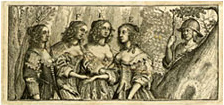J. Ralphson, A Mathematical Dictionary (1702)
Full Text
Not available
EEBO/TCP
Not available
Date
1702
Editor
Lexicographer
Book title
A Mathematical Dictionary: or, a Compendious Explication of all Mathematical Terms, Abridg'd from Monsieur Ozanam, and Others. With a Translation of his Preface; and an Addition of several easie and useful Abstracts; as plain Trigonometry, Mechanicks, the first Properties of the three Conick Sections, &c. To which is added, an Appendix, containing the Quantities of all Sorts of Weights and Measures; the Explanation of the Characters used in Algebra. Also the Definition and Use of the Principal Mathematical Instruments, and the Instruments themselves curiously Engraven on Copper.
Publication place
London
Publisher
J. Nicolson, T. Leigh, and D. Midwinter
Transcription source
Thomas Fisher Rare Book Library: Fisher sci 02141
Text type
printed book
Genre
Hard-word, term-of-art, and dialect dictionaries, glossaries, and definitions
Subject area
mathematics
Language
headwords: English
explanations: English
explanations: English
explanations: English
explanations: English
Word-group
type: alphabetical
Word-entry
type: headword
sample: Fluxions, in Geometry is a new Improvement of it upon the Doctrine of Indivisibles and Arithmetick of Infinites; invented by the celebrated Mr. Newton of Cambridge; though at the same time or thereabouts, also found out under other Terms and a different way of Notation by the Heer Leibnitz of Germany, and passes there and in France, under the Name of Leibnitz's Differential Calculus, or Calculus of Differences, which Differences or Fluxions are supposed to be Quantities infinitely small, whereby finiste ones considered as indeterminate are perpetually augmented or diminished, which upon that Account are called by Mr. Newton Flowing ones. Hence Geometricians contemplate the Generation and Nature of Curvatures of infinite kinds, whereby they come to compendious Methods of, 1. Finding Tangents to all sorts of Curves; 2. Rectifying the Curve-lines, 3. Finding their Areas, Solidities, &c. 4. Finding the Maxima and Minima, and almost whatever besides the most intricate and recluse Parts of Geometry require. Mr. Newton's way of Notation herein will be found the most easie and natural, a Specimen whereof may be seen in the 2d. Vol. of Dr. Wallis's Works, the last Edition, Printed in Latin, &c.
sample: Fluxions, in Geometry is a new Improvement of it upon the Doctrine of Indivisibles and Arithmetick of Infinites; invented by the celebrated Mr. Newton of Cambridge; though at the same time or thereabouts, also found out under other Terms and a different way of Notation by the Heer Leibnitz of Germany, and passes there and in France, under the Name of Leibnitz's Differential Calculus, or Calculus of Differences, which Differences or Fluxions are supposed to be Quantities infinitely small, whereby finiste ones considered as indeterminate are perpetually augmented or diminished, which upon that Account are called by Mr. Newton Flowing ones. Hence Geometricians contemplate the Generation and Nature of Curvatures of infinite kinds, whereby they come to compendious Methods of, 1. Finding Tangents to all sorts of Curves; 2. Rectifying the Curve-lines, 3. Finding their Areas, Solidities, &c. 4. Finding the Maxima and Minima, and almost whatever besides the most intricate and recluse Parts of Geometry require. Mr. Newton's way of Notation herein will be found the most easie and natural, a Specimen whereof may be seen in the 2d. Vol. of Dr. Wallis's Works, the last Edition, Printed in Latin, &c.
STC
T139078




